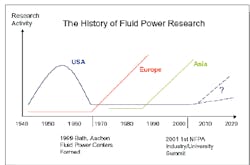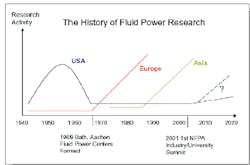These are great times for fluid power
Sitting at my desk, I daydream about what it must've been like to work in the 1960s and late 50s — what many would consider the heyday of fluid power. Air travel would've been much more convenient — long before security lines were needed. Even more intriguing would be having a secretary to open your mail, write letters, and handle much of the routine paperwork that takes up so much the day.
The familiar beep of an e-mail on my computer pops me back into reality. Maybe this one is a follow-up to my request for more information on a new hydraulic hybrid vehicle drive. Or maybe it's correspondence with an image attached showing the latest hydraulic fan drive. Then again, it might be a manuscript about a multifunctional hydraulic system that is lighter, smaller, and more efficient than the electric drives it replaces. But it may also explain how replacing multiple engine-driven belt drives with a single hydraulic system can slash maintenance costs.
All of these scenarios — and more — are in the works. And in my nearly 20 years working on H&P, I have never heard of so much activity occurring at the same time.
In addition, the U. S. appears to be at the forefront of renewed activity in fluid power research. Kim A. Stelson, director, Engineering Research Center for Compact and Efficient Fluid Power at the University of Minnesota, authored a paper outlining the amount of investment in fluid power research across the globe. As a graphic from that paper depicts, the U. S. led the world in fluid power R&D for two decades following WWII, and activity peaked in the 1960s before dropping off sharply around the same time R&D ramped up in Europe.
Since then, the majority of large-scale research has occurred overseas. But as Stelson's graphic implies, activity in fluid power research in the U. S. gained new momentum with the first NFPA Educator-Industry Summit launched in 2001, and more recently with the $15 million, 5-year Fluid Power Research Center awarded by the National Science Foundation. Read details on the Editor's Page of our July 2006 issue, in our issue archive at www.hydraulicspneumatics.com, or at www.nfpa.com.
So with all the new developments in fluid power technology, the Educator-Industry Summit, and the Fluid Power Research Center, things are really looking up for fluid power technology. And who knows? Maybe future generations will refer to the early 21st century as the heyday for fluid power.
Alan L. Hitchcox
editor
[email protected]


